Back to page 1
The Essentials
While the list of fan amenities doesn’t quite approach the endless list that 2009’s Citi Field offered, it is far more than adequate. In fact, I’d go so far as to say that it is miraculous considering the small site that architects had to work with.
While I’m a little alarmed at the increase in ticket prices over 2009 (as you’ll read below), fans attending a Twins game will enjoy themselves immensely … once they get used to the fact that the green in front of them is real grass and there’s no roof above their heads!
As we always do in these in-depth reviews, let’s examine what it’s like to attend a game at Target Field.
We’ve already described in detail all of the ways you can get to the park, but if you do the conventional thing and drive, you’ll find the three main parking “ramps” (A, B and C) charge $15. Note that if you park here and decide to leave when everyone else does after the final out, it could take you quite awhile to depart the facility.
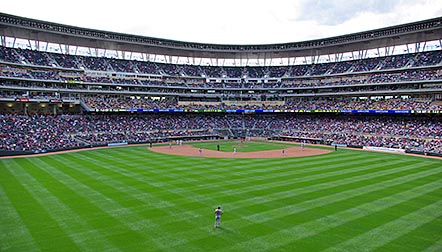 |
Now, let’s talk about tickets. It’s not that the Twins overcharge for their tickets relative to other teams. It’s that they raised the prices so much from their last year in the Metrodome. In 2009, the average ticket price for Twins home games was $21.70. In their first year at Target Field, the average ticket price is $31.47, a rather shocking increase of 45%, especially when you consider that the average increase from 2009 to 2010 was 1.5%. (All figures are from the Team Marketing Report.)
For a small market team, the Twins’ average of $21.70 in 2009 was certainly acceptable. In fact, it put them in the middle of the pack. In 2010, though, the $31.47 pricetag puts them behind only six other MLB teams, and they are all definitely of the “large market” variety.
| Remembering the Met |
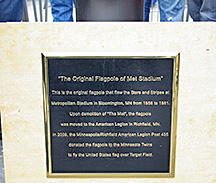 |
| Target Field pays homage to Twins history in many ways. One of my favorites is the presence of the same flagpole that was in Metropolitan Stadium when the team played there until 1981. Where had it been in the meantime? At the Richfield, MN American Legion, which donated it to be used at Target Field. |
A new park certainly means increased revenues, and the Twins increased payroll by 46% for 2010 and locked up young stars (ever heard of Joe Mauer?) while banking on that revenue bump. Indeed, before the end of spring training in 2010, the Twins had sold over 2.6 million tickets for home games in the regular season, and the total sellable seats for the entire 81-game schedule is only 3.2 million. Not only that, the team increased its season-ticket base from 11,000 in 2009 to 24,500 for the first year in Target Field.
So if “supply and demand” holds true, the way Twins’ fans are gobbling up tickets means that they don’t think they are overpriced … plus it’s nice to see the team invest this additional revenue into player salaries. Everyone seems satisfied.
So how much do tickets cost? The very, very premium seats in the Champions section directly behind the backstop cost from $175 to $275 a game, and can only be purchased as part of season tickets. What do those same seats cost in the new park in the Bronx? $1,250 to $2,500 a seat.
The Twins have jumped on board what most MLB franchises now do: charge more for “premium” games. In fact, games are categorized as being “value,” “select” or “premium.” The most expensive seats that are not sold only as season tickets are the Dugout Boxes. They cost $77 for value games, $79 for select contests and $82 for the most desirable match-ups. The majority of the infield seats on the field level are called Home Plate Boxes, and they cost $57, $59 and $62, respectively. The Field Boxes which are well down the foul lines are a reasonable $32, $34 and $37.
The Overlook seats and (wood) Pavilion seats cost the same as each other: $22-$27. The left-field bleachers cost more than those on the right-field side (probably because they are all in fair territory in the outfield) at $19-$24, all $2 more than the benches in right field. Several of the sections add a $5 or $10 premium onto the price if your seat is in the first row.
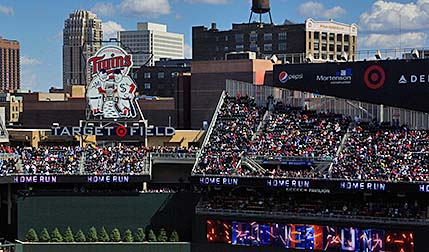 |
As you move up to the Club Level, all of the Legend’s seats are sold only as season tickets (at $55 or $48 per seat, depending on location, plus you have to pay for a membership to the Legend’s Club). The Skyline Deck seats down the third-base line cost $27-$32 per game and don’t require a membership.
In the outfield, the Batters Eye seats (left-hand portion of the photo above) and the lower level of the Home Run Porch cost $22-$27, while the upper level Porch seats go for $18-23. The Grandstand seats high above right-center field (right-hand portion of the shot above) also cost $18-23.
The price of tickets in the uppermost levels of the main seating bowl are very dependent on the location of the section. The best sections, called the Home Plate Terrace, carry a somewhat high price of $32-37, while the higher-up and down-the-first-base-line Field View seats cost $11-16. These, indeed, are the cheapest seats in the stadium. Their comparable location on the third base side costs more ($13-18) because you can gaze at that stunning view of the downtown skyline. Easily worth the extra $2, in my opinion.
And in case you’re interested, the Twins state that all seats except the bleachers have cup holders.
There’s also the Budweiser Roof Deck, which is rented out by groups for most games, but on Thursdays and Saturdays, you can buy a ticket here without being part of group (note that those tickets were largely gone for the 2010 season prior to Opening Day). There are 120 barstools at counters (below left), plus one of the ballpark’s most popular features on cool days is located here: MLB’s only firepit (below center). Yes, it offered welcome warmth when I visited during the exhibition games prior to the start of the regular season.
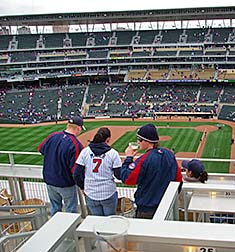  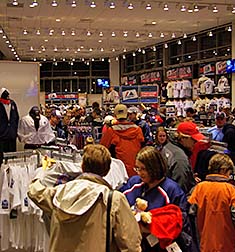 |
There are souvenir stands scattered all around the park, four of which are ones you can walk into (there were none at the Metrodome). It’s worth visiting the main one by Gate 29 near right field. The Majestic Twins Clubhouse Store (above right) offers 4,600 square feet of merchandise, but if you’re looking for bargains, you won’t find many here. The prices are what you’re finding at MLB parks these days. For instance, most adult T-shirts cost $25, $26 or $30. Yes, that’s kind of high.
| Sound effects |
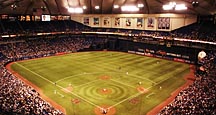 |
| A huge difference between Target Field and the Metrodome (above) is the quality of the sound system. Twins fans can now hear the PA system very clearly. I’ve long felt that their old home had the worst accoustics of any sports facility ever built. There were times I was sitting in the Metrodome’s upper deck when I couldn’t tell what was playing through the the stadium’s speakers — to the point of not being able to tell whether the PA announcer was talking or music was being played! |
Oh, they do sell food at Target Field. Do they ever! And best of all, the Twins made a conscious effort to provide a local feel in the food offerings — or sometimes a “Twins feel.”
By my count, there are over 60 food stands at the park, and they serve almost 70 different food items — and this doesn’t include the ever-changing offerings at the sit-down restaurants on the Club Level. My favorite stand is located on the main concourse near center field. Called State Fair Classics, this stand tries to replicate some of the deep-fried delicacies you find at the incredibly popular Minnesota State Fair. I loved the most expensive item on the menu there, which is called “Walleye on a Spike” (below left). This is a handsome filet of fish that is fried and stuck onto a pointy wooden stick for $11.00. You’ll also find roasted turkey legs here for $9.75, “porkchop on a stick” for $7.25 and fried cheese curds (below center) for $4.75.
Behind home plate, you’ll find Tony O’s Cuban stand, named for Twins great Tony Oliva. His signature dish is indeed a flavorful Cuban Sandwich for $9 (below right).
Minnesotans love the fact they can buy sausages from Kramarczuk’s, a landmark in Minneapolis for over half a century, and the hot dogs are by Schweigert, which has been making various sausage and meat products in the Twin Cities since 1937. In fact, the “Original Twins Dog” which is available at quite a few stands around the park, is made from the same recipe as the dogs sold at Metropolitan Stadium when the Twins played there in the 1960s. As a matter of fact, Schweigert is responsible for four different kinds of hot dogs at Target Field. In addition to the Original Twins Dog, there are also the quarter-pound beef Big Dogs (based on articles and fan reaction, these seem to be the favorite), the extra-long pork-and-beef Dinger Dogs and the steamed Dugout Dogs, which are sold only by vendors in the stands. In other words, gone are the Dome Dogs that were sold by the hundreds of thousands at the Metrodome.
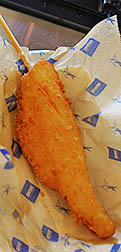 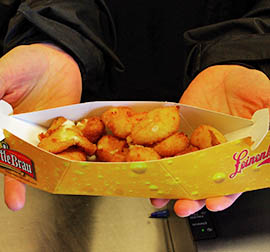  |
Two other establishments deserve mention. Hrbek’s, named for the Twins’ beloved firstbaseman (who grew up in nearby Bloomington), serves up simple pub grub and a variety of beers (below left). It’s on the main concourse just inside the gate named for Hrbek’s number (14). The Town Ball Tavern (below center) is a larger establishment near the left-field foul pole. This is a popular, crowded sports bar. If you visit it, take a good look at the floor (below right). This is the very hardwood flooring that the Minneapolis Lakers played on before they left for LA in 1960.
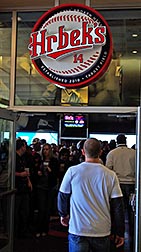 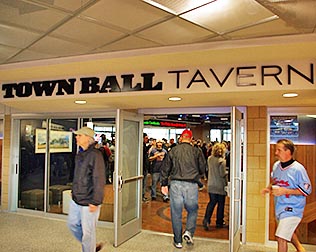 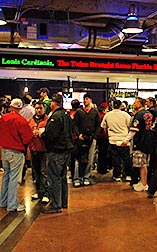 |
For adults, there are so many bars and eateries to explore that you could forget there’s a game going on. For kids, though, there aren’t quite as many distractions. By no means do I think that Target Field isn’t kid-friendly, but I was a little surprised that there weren’t several designated play zones for the younger set.
Maybe they’ll stay entertained gazing at the remarkable LED scoreboard high above left field (below left). I believe it is the second largest video screen in the Majors (trailing only the monstrously large board at remodeled Kauffman Stadium), and all 5,757 square feet of it is in glorious 1080p. It’s not an overstatement to say that it is absolutely stunning. There is also a video board above the bullpens that provides useful information about the pitchers.
  |
And I have to mention two very special touches that you’ll only find at Target Field. First, along the main concourse from the right field corner all the way around to the left-field foul pole, there are radiant-heat fixtures attached to the ceiling. Also, the restrooms are heated, as are a number of the concession areas. Yes, it gets cold in April and October (and a fair amount in between) in Minneapolis, so there are ways to thaw out if you look for them.
The second special touch that is unique to Target Field is the “celebration sign,” which is a reminder of the team’s roots. High above center field is a 46-foot-tall sign depicting the team’s logo from the ’60s (above right). It shows two twins, nicknamed Minnie and Paul, with the Mississippi River running between them. When a player for the home team hits a homer, special lights speed around its periphery, and neon lights indicate that Minnie and Paul are shaking hands.
Summary
As we pointed out in the intro, the Twins first broached the subject of a new ballpark in 1994. Their timing couldn’t have been worse, because the entire country soured on baseball when the strike occurred, wiping out the final seven weeks of the regular season and the entire post-season. Even as the Twins’ attendance was cratering to barely a million, the team started lobbying in earnest the following year, suggesting a $300 million retractable-roof facility like the one proposed for downtown Phoenix. Within a year, the estimate for the park had climbed to $354 million. A year later, it was $425 million.
After referendums in North Carolina in 1998 and St. Paul in 1999 were rejected by voters, and the Twins’ owner offered the franchise for “contraction” in 2001, new proposals start circulating that estimated that a new park would cost $450 million. By 2005, the Twins and Hennepin County agreed in principle to a plan for a $478 million stadium, but the Minnesota legislature failed to provide its blessings. Finally, in May of 2006, the State Senate approved (by a scant two votes) a plan for a $522 million stadium for the Twins. When all was said and done (including cost overruns, which always seem to happen), the total price tag for Target Field and the infrastructure changes around it was $545 million.
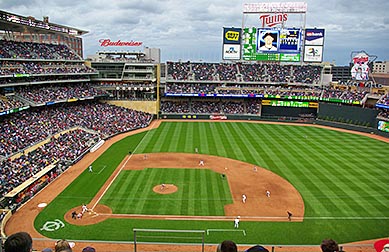 |
Where did the money come from? Well, Hennepin County residents are currently paying an additional 0.15% sales tax, and that is generating approximately $350 million. The Twins, who had pledged $130 million when the deal was being finalized in 2006, will end up paying $195 million. That total is made up of the original $130 million, $45.5 million for enhancements within the ballpark, $4.5 million toward the construction of Target Plaza (Target Corporation also chipped in $4.5 million for the plaza that carries their name) and $15 million to help pay for infrastructure improvements surrounding the park. Note that it helps the team that they get to keep the money from the naming rights of the stadium, although we don’t know how much Target paid for this since the deal was never made public.
Anyway, if you feel that $545 million paid for a very nice ballpark, then you would be right on target (sorry, couldn’t resist).
Finally, many Twins fans entered the 2010 season worried that Target Field won’t provide as much of a home-field advantage as the wretched Metrodome. Reporter Joe Christensen conducted some impressive research to establish a baseline for comparison. From 2001 through 2009, the Twins had a winning percentage of .603 at home and .486 on the road. That differential of .117, then, can be compared to other teams during the same period. Indeed, only the Rockies, playing in the thin air of Coors Field, and the Rays had greater differentials between home records and road records. I would also add that during the Twins’ two trips to the World Series (’87 and ’91), they won every game in the deafening Metrodome (going 8-0) while losing every road game. Lucky for them, the American League team got to play four games at home each time, or else they might still be looking for their first World Championship instead of having two trophies to display at their fancy new Champion’s Club at Target Field.
So the Twins’ home-field advantage was among the biggest in the sport. Target Field won’t be as loud as the Metrodome, and visiting outfielders won’t have nearly as much trouble finding fly balls as they did when looking up at the underside of that big pillowcase that covered the old stadium.
But, I would submit that the additional revenue from tickets, concessions, suites, advertising, etc., etc., etc. — money that will keep young stars from fleeing the state of Minnesota when they become free agents — more than makes up for the loss of the dome’s home-field advantage. After all, first-class players will usually trump the amount of noise the fans can generate.
Even when those first-class players are performing on a plot of ground the size of a postage stamp.